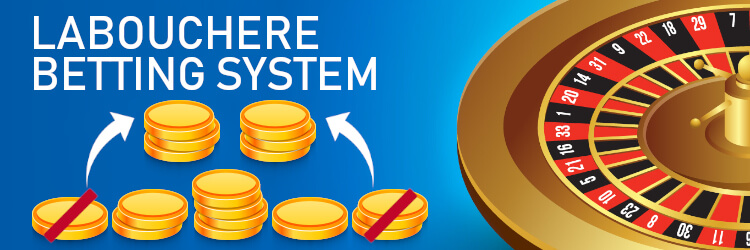고정 헤더 영역
상세 컨텐츠
본문

- Labouchere Roulette Betting System Strategy Chart
- Labouchere Roulette Betting System Strategy Definition
- Labouchere Betting System

First and foremost, fans of the Labouchere betting system insist that it is best used on even money roulette wagers. The Labouchere can easily be used without the aid of a calculator, but a pen and paper are a necessity for most players. First and foremost, fans of the Labouchere betting system insist that it is best used on even money roulette wagers. The Labouchere can easily be used without the aid of a calculator, but a pen and paper are a necessity for most players.
To be profitable in sports betting, staking strategy is as important as finding value odds. With many progressive staking systems, such as the Labouchere system, promising almost infinite wealth, are they a good idea to follow? Here’s the academic answer to the question.
The Labouchère staking system is a progressive staking method acording to which a bettor continues to bet until a particular winning amount is reached, and is traditionally used for Roulette.
The Labouchère staking method in sports betting
Labouchère can be easily extended to sports betting and the steps involved in applying this staking method are the following:
- Decide how much money you want to win. Let's aim, for example, to win $100.
- Determine how you will split this money. Say you split it up over five values: $10, $20, $40, $20, $10.
- Place a bet that would win the sum of the first and last numbers. If the European/Decimal odd is 3 (+200 American/MoneyLine) for example, you would stake $10, so as to win $20 back (the sum of the first and last number).
- If you win, you tick off the first and last number. Otherwise, you add the amount of the stake you made, so that you need to win this back. In this case, you would have $10, $20, $40, $20, $10 and $10.
- Repeat steps 3 and 4 until you win the amount you are aiming for.
The rationale behind this strategy is that you tick two items off the list when you win, but you only add one; so you are ticking it faster than you are adding. Below I discuss why this doesn’t make sense.
To recommend or not to recommend?
While it is fun to deal with, I would not recommend any progressive staking methods. In essence, they suggest you bet and bet until you win the desired amount, without heeding the amount you afford to bet. Let ‘s assume you are betting on even odds and have a run of four losses. The next bet would then be $50, even if you had already lost $100.
Unlike the Kelly Betting strategy, no consideration is taken to the size of the portfolio.
Popular staking method which suggests that stake should be proportional to the perceived edge.
It is important to remember that the key decision in sports betting should be whether the odds represent value, rather than how much can be won.
A similar progressive system is the Fibonacci strategy, where you increase your betting stake according to the Fibonacci sequence 1, 1, 2, 3, 5, 8, 13, 21 etc.
The academic answer
From an academic perspective, there have been three good papers discussing the use of this strategy to bet on draws. In 2007, Archontakis and Osborne stated that betting on draws at an odd of 3 using a Fibonacci Strategy would result in wins, if applied to World Cup Finals data.
Tread on with caution. Progressive systems are fun, but only while the fun lasts.
Labouchere Roulette Betting System Strategy Chart
Yet they didn’t use real data, so another team of researchers focused on real odds for draws and simulated the results (Is the soccer betting market efficient? A cross-country investigation using the Fibonacci strategy). They found that in 95% of the cases, the worst case scenario is to have to stake up to 43, if the Fibonacci strategy is used.
More recently, however, Lahvička debunked the theory of succes behind these methods by finding that all tested versions of this strategy eventually result in money loss. I would expect any progressive system to provide similar results.
So, tread on with caution. Progressive systems are fun, but only while the fun lasts.
While no betting strategy can lower the house advantage in roulette, many players remain convinced that the Labouchere system works in the long run. With that in mind, let’s take a closer look at this cancellation-based strategy and see how it stacks up against other popular methods.
Recommended Internet roulette casinos



How the Labouchere strategy works
The first step of the Labouchere betting system is to decide how much money you want to win during your roulette session. Once you figure that out, you can then divide that amount into however many betting units. For example: a target of $50 would make 10 units of $5 each.
The next move is to write out a list of numbers which adds up to the total amount of units you wish to win. If we’re aiming for 10 units, for instance, we might jot down the following:
1 1 2 2 2 1 1
Now you must choose your bet. This system is most effective with the even-money wagers (black or red, even or odd, et cetera). Whichever option you pick, make sure to stick with it start to end. There’s no point even attempting this strategy if you’re going to play a different bet type from spin to spin.
With this method, every stake is the sum of the two numbers on each end of the list. If the bet wins, you cross out both numbers; if it loses, you add the sum of both numbers to the end of the list.
For example: if our list starts out as 1 1 2 2 2 1 1, our first wager is two units. If we win, we cross out both numbers to leave us with 1 2 2 2 1; if we lose, we add the two units to the end so the list becomes 1 1 2 2 2 1 1 2.
The aim of the game is to cross out all the numbers and thus complete the sequence, in which case you will reach your profit goal.
Advantages of the cancellation system
There is actually a little bit of merit to the theory behind the Labouchere strategy. Because you eliminate two numbers for a win and only add one for a loss, you don’t need a very high win-loss ratio overall to complete a pattern and make a profit.
For example, let’s say we start with 1 2 3 4 5 and lose six out of 10 spins:
1 2 3 4 5 – bet six, lose
1 2 3 4 5 6 – bet seven, lose
1 2 3 4 5 6 7 – bet eight, win
2 3 4 5 6 – bet eight, lose
2 3 4 5 6 8 – bet 10, win
3 4 5 6 – bet nine, lose
3 4 5 6 9 – bet 12, win
4 5 6 – bet 10, lose
4 5 6 10 – bet 14, win
5 6 – bet 11, lose
Even though we have won only four spins, we are only a couple of hits away from finishing the list and securing a 10-unit win.
The longer you play, the better the chances that this system will produce a positive result. For while even-money bets are expected to win just over 47 per cent of the time in European roulette, they only need to hit at a rate of about 33 in every 100 spins in order to finish a Labouchere sequence.
Drawbacks of the Labouchere betting strategy
As with the vast majority of roulette betting systems, the cancellation strategy affects the volatility of the game in the short-term rather than the actual odds of long-term success. Most significantly, this means you can suffer big losses in a very brief period of time.
For example, let’s say we are playing in $10 units and start with a list of 1 1 2 3 2 1 1. What if we lose on each of the first five spins?
Labouchere Roulette Betting System Strategy Definition
1 1 2 3 2 1 1 – bet two, lose
1 1 2 3 2 1 1 2 – bet three, lose
1 1 2 3 2 1 1 2 3 – bet four, lose
1 1 2 3 2 1 1 2 3 4 – bet five, lose
1 1 2 3 2 1 1 2 3 4 5 – bet six, lose
That would leave us $200 down (0 – $20 – $30 – $40 – $50 – $60) and facing a $70 bet next time up. If we have a bankroll of only $300, one more loss will effectively put us out of the game.
Labouchere Betting System
The Labouchere is also known as the Split Martingale system, and it shares the same problem as the source of that name: if you suffer a heavy run of losses, your stakes can inflate to the point where you can’t play the next bet because it would exceed the table limit.




